India reports over 400,000 daily cases for the third time in a week as second wave hammers country, at the same time a rare fungal infection Mucormycosis is one of the common post-coronavirus complications which has been observed in patients in in many parts of India. Those with uncontrolled diabetes and heavy use of steroid to survive Covid-19 complications are worst affected.
Last year, this deadly infection caused a high mortality with many patients suffering from loss of eye sight, removal of nose and jaw bone according to Dr Manish Munjal, a senior ENT surgeon at SGRH reported in News18. This year we are seeing a rise again in this dangerous fungal infection triggered by Covid-19.
According to the CDC (Centre for Diseases Control and Prevention) USA, Mucormycosis (previously called zygomycosis) is a serious but rare fungal infection caused by a group of molds called mucormycetes. These molds live throughout the environment. Mucormycosis mainly affects people who have health problems or take medicines that lower the body’s ability to fight germs and sickness. It most commonly affects the sinuses or the lungs after inhaling fungal spores from the air. It can also occur on the skin after a cut, burn, or other type of skin injury.
According to businesstoday reports on 7 may 2021, Six cases of mucormycosis, due to COVID-19 were admitted in the last two days at Delhi's Sir Ganga Ram Hospital
Where Mucormycosis Comes From
Mucormycetes, the group of fungi that cause mucormycosis, are present throughout the environment, particularly in soil and in association with decaying organic matter, such as leaves, compost piles, and animal dung. 1 They are more common in soil than in air, and in summer and fall than in winter or spring. 2-4 Most people come in contact with microscopic fungal spores every day, so it’s probably impossible to completely avoid coming in contact with mucormycetes. These fungi aren’t harmful to most people. However, for people who have weakened immune systems, breathing in mucormycete spores can cause an infection in the lungs or sinuses which can spread to other parts of the body.
Symptoms of Mucormycosis
Symptoms of rhinocerebral (sinus and brain) mucormycosis include:
- One-sided facial swelling
- Headache
- Nasal or sinus congestion
- Black lesions on nasal bridge or upper inside of mouth that quickly become more severe
- Fever
Symptoms of pulmonary (lung) mucormycosis include:
- Fever
- Cough
- Chest pain
- Shortness of breath
Cutaneous (skin) mucormycosis can look like blisters or ulcers, and the infected area may turn black. Other symptoms include pain, warmth, excessive redness, or swelling around a wound.
Symptoms of gastrointestinal mucormycosis include:
- Abdominal pain
- Nausea and vomiting
- Gastrointestinal bleeding
Source: CDC
